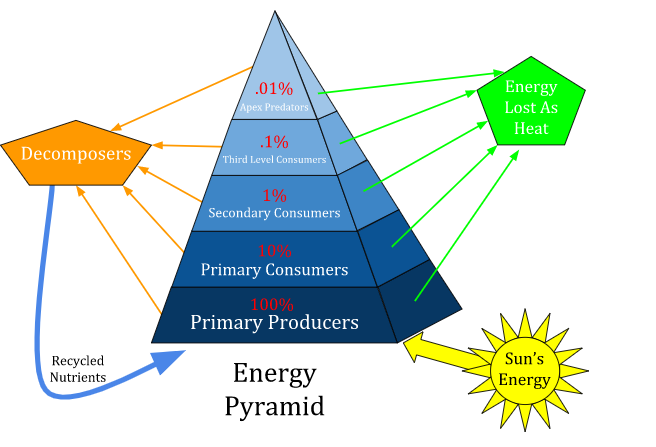
Draw a diagram of the pyramid of energy. In the ecosystem, energy flow is unidirectional. Explain.
Answer
456.9k+ views
Hint: The energy pyramid shows the flow of energy from one level to another trophic level in a community. The shape of the energy pyramid is always straight or triangular because the time factor is always taken into account. An energy pyramid represents the total amount of energy consumed by various organisms at the trophic level of an ecosystem over a limited area over some time (usually per square meter per year).
Complete answer:
Pyramid of energy -It represents the total energy of the body at each trophic level. The energy pyramid is always upright and never inverted. When energy is transferred from one power level to another, the energy is always dissipated as heat at each stage, so it cannot be reversed.

The amount of energy and substances transferred with food to higher levels decreases. More energy is available at the producer level than at the primary consumer (grazing). Energy production by primary consumers is higher than that of secondary consumers (i.e. primary predators), which form the next link in the energy chain. The actual percentage or percentage of food energy at one level that is converted to food energy at the next level may be more than 10% or less than 10%. This shared pattern forms an energy pyramid because less energy is available for subsequent trophic levels.
This indicates not only the total amount of energy consumed by the body at each trophic level in the food chain but, most importantly, the actual role of different organisms in energy transfer. At the producer level, total energy will be much higher than the next highest trophic level.
Reason for unidirectional flow of energy:
During the flow of energy, two things appear. First, there is a way of moving energy (unidirectional). The one-way flow of energy. Energy enters the ecosystem from external sources. The energy absorbed by autotrophs does not return to the sun, the energy transferred from autotrophs to grazing animals does not return, and since this energy gradually passes through different trophic levels, this energy is no longer transferred.
The system collapses when the primary energy source, the sun, loses power due to a one-way flow of energy. Second, energy levels gradually decrease at each nutritional level, mainly because they are released as heat during metabolic activity.
Note: Some producing organisms may have low biomass, but the total energy they consume and deliver to consumers may be greater than that of organisms with much higher biomass. The higher nutritional value uses energy more efficiently, but more heat is lost during energy transfer. The loss of energy in the airways also gradually increases from a low trophic level to a high level.
Complete answer:
Pyramid of energy -It represents the total energy of the body at each trophic level. The energy pyramid is always upright and never inverted. When energy is transferred from one power level to another, the energy is always dissipated as heat at each stage, so it cannot be reversed.

The amount of energy and substances transferred with food to higher levels decreases. More energy is available at the producer level than at the primary consumer (grazing). Energy production by primary consumers is higher than that of secondary consumers (i.e. primary predators), which form the next link in the energy chain. The actual percentage or percentage of food energy at one level that is converted to food energy at the next level may be more than 10% or less than 10%. This shared pattern forms an energy pyramid because less energy is available for subsequent trophic levels.
This indicates not only the total amount of energy consumed by the body at each trophic level in the food chain but, most importantly, the actual role of different organisms in energy transfer. At the producer level, total energy will be much higher than the next highest trophic level.
Reason for unidirectional flow of energy:
During the flow of energy, two things appear. First, there is a way of moving energy (unidirectional). The one-way flow of energy. Energy enters the ecosystem from external sources. The energy absorbed by autotrophs does not return to the sun, the energy transferred from autotrophs to grazing animals does not return, and since this energy gradually passes through different trophic levels, this energy is no longer transferred.
The system collapses when the primary energy source, the sun, loses power due to a one-way flow of energy. Second, energy levels gradually decrease at each nutritional level, mainly because they are released as heat during metabolic activity.
Note: Some producing organisms may have low biomass, but the total energy they consume and deliver to consumers may be greater than that of organisms with much higher biomass. The higher nutritional value uses energy more efficiently, but more heat is lost during energy transfer. The loss of energy in the airways also gradually increases from a low trophic level to a high level.
Recently Updated Pages
Master Class 12 English: Engaging Questions & Answers for Success

Master Class 12 Business Studies: Engaging Questions & Answers for Success

Master Class 12 Social Science: Engaging Questions & Answers for Success

Master Class 12 Chemistry: Engaging Questions & Answers for Success

Class 12 Question and Answer - Your Ultimate Solutions Guide

Master Class 12 Economics: Engaging Questions & Answers for Success

Trending doubts
Which are the Top 10 Largest Countries of the World?

Differentiate between homogeneous and heterogeneous class 12 chemistry CBSE

What is a transformer Explain the principle construction class 12 physics CBSE

Draw a labelled sketch of the human eye class 12 physics CBSE

What are the major means of transport Explain each class 12 social science CBSE

What is the Full Form of PVC, PET, HDPE, LDPE, PP and PS ?




